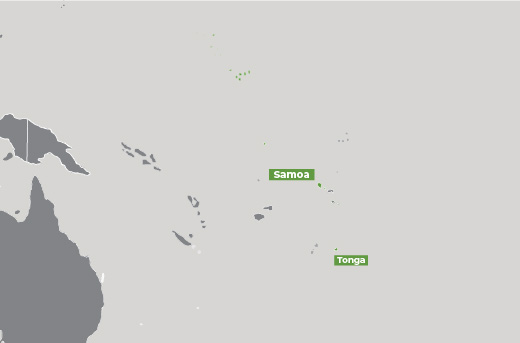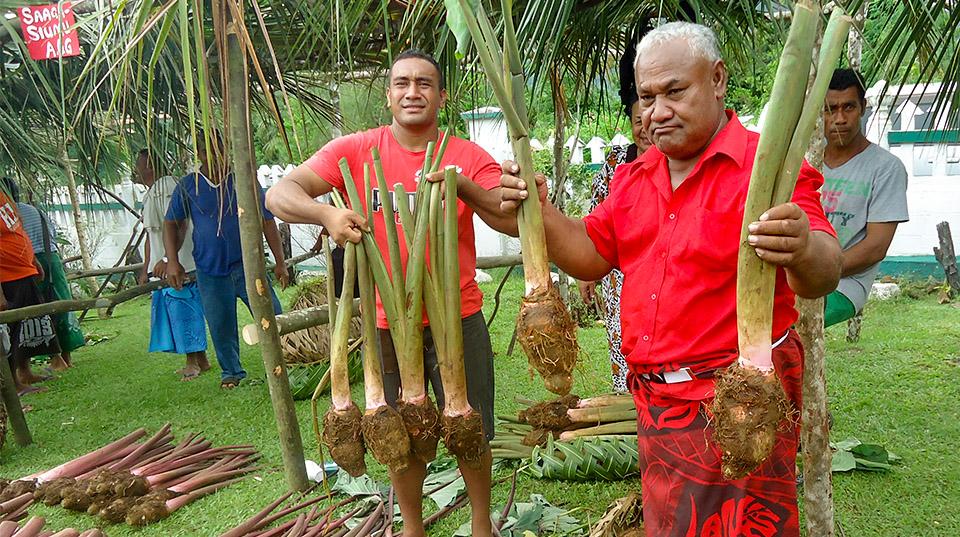Overview
This project aims to evaluate biophysical and economic benefits of multiple Sustainable intensification of agriculture (SI) practices in crop-based farming systems in Samoa and Tonga, focusing on SI practices most likely to provide climate adaptation and mitigation benefits.
The project also aims to begin to assess the practicality of SI practices from the perspective of farmers and use all trials as opportunities to engage farmers, governments, businesses, and agriculture scholars in dialogue about the feasibility of SI to support climate-resilient development in the Pacific.
Climate impacts on agriculture in the Pacific include rising sea levels and salinity intrusion, more severe tropical cyclones, more periods of drought and increased unpredictability of rainfall—all of which are expected to have moderate to strong impacts on both staple food crops (such as taro, rice, and sweet potato) and high value cash crops (such as tomato, mango, and papaya; Bell et al. 2016). SI of agriculture (SI) is based on 5 complementary components (Reeves 2020) that when acting together should provide greater benefits than the sum of the individual parts acting alone. While each part can separately contribute improvements, it is their integration into sustainable intensification that results in 'phase-shift' improvements in function. These components can be summarised as Conservation agriculture, Healthy soils, Improved crops, varieties, and livestock, Efficient water management, and Integrated pest management.
While the 5 complementary components remain the same, the detailed management actions and changes involved in SI must be tailored to local environments and farming systems and tested in context (Vanlauwe et al. 2014). Given the emerging success of SI in other parts of the world and the need for biophysical systems change options to underpin climate smart agriculture (CSA) in the Pacific, it would be useful to understand whether and what types of SI farming system changes could contribute to multiple goals in a context of climate change and thus sit at the heart of CSA in the Pacific.
This project tests the benefits of targeted SI farming system changes in Samoa and Tonga and sets the stage for considering broader implementation through farmer engagement and national and regional dialogue.
Expected project outcomes
- Better understanding of the biophysical and basic economic net benefits associated with individual SI components and their interactions in an experimental setting compared with current common management practice in the two farming systems.
- Ability to distinguish between ideal and current practical approaches to SI and thus early indication of potential barriers to and enablers of SI implementation, including gendered implications.
- Improving understanding in the SI scientific community about experimental and analytical methods for how more than a sum of the parts and multiple goals can be assessed.
- Improving knowledge of how farming system change can be supported with farmers in these particular social and cultural contexts, including through understanding some potential barriers and enablers.
- Stronger relationships with the most effective enabling organisations to work in partnership.
- Improved awareness of and skills in co-design and co-governance of action-oriented research.
- Stronger skills in research leadership for career development (particularly D Gupta).
- New knowledge of additional farming practices and their interaction in a system, including the foundational role of nutrients
- Understanding of the differences between ideal and current practical application of SI components, including the differences in net benefits.
- Understand some kinds of support farmers need, to put SI into practice.
- Know how to support farmers to trial and evaluate SI components and have access to the guides to assist them in providing this support.




